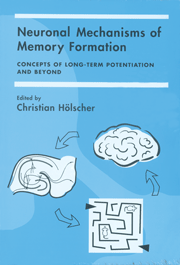Book contents
- Frontmatter
- Contents
- Contributors
- Introduction: Long-Term Potentiation as a Model for Memory Mechanisms: The Story So Far
- Section One Long-Term Potentiation In Vitro and In Vivo: How Can We Fine-Tune the Current Models for Memory Formation?
- Section Two There is More to the Picture Than Long-Term Potentiation: Theta or Gamma Oscillations in the Brain and the Facilitation of Synaptic Plasticity
- 5 Synaptic Potentiation by Natural Patterns of Activity in the Hippocampus: Implications for Memory Formation
- 6 Plasticity in Local Neuronal Circuits: In Vivo Evidence from Rat Hippocampus and Amygdala
- 7 Theta-Facilitated Induction of Long-Term Potentiation: A Better Model for Memory Formation?
- 8 Role of Gamma Oscillations for Information Processing and Memory Formation in the Neocortex
- Section Three Making Models from Empirical Data of Synaptic Plasticity
- Section Four Setting the Stage for Memory Formation: Stress, Arousal, and Attention
- Section Five Transgenic Mice as Tools to Unravel the Mechanisms of Memory Formation
- Conclusions and Future Targets
- Index
8 - Role of Gamma Oscillations for Information Processing and Memory Formation in the Neocortex
Published online by Cambridge University Press: 13 October 2009
- Frontmatter
- Contents
- Contributors
- Introduction: Long-Term Potentiation as a Model for Memory Mechanisms: The Story So Far
- Section One Long-Term Potentiation In Vitro and In Vivo: How Can We Fine-Tune the Current Models for Memory Formation?
- Section Two There is More to the Picture Than Long-Term Potentiation: Theta or Gamma Oscillations in the Brain and the Facilitation of Synaptic Plasticity
- 5 Synaptic Potentiation by Natural Patterns of Activity in the Hippocampus: Implications for Memory Formation
- 6 Plasticity in Local Neuronal Circuits: In Vivo Evidence from Rat Hippocampus and Amygdala
- 7 Theta-Facilitated Induction of Long-Term Potentiation: A Better Model for Memory Formation?
- 8 Role of Gamma Oscillations for Information Processing and Memory Formation in the Neocortex
- Section Three Making Models from Empirical Data of Synaptic Plasticity
- Section Four Setting the Stage for Memory Formation: Stress, Arousal, and Attention
- Section Five Transgenic Mice as Tools to Unravel the Mechanisms of Memory Formation
- Conclusions and Future Targets
- Index
Summary
SUMMARY
The neuronal code that is used by the brain to represent complex information is not yet identified. Two complementary representational strategies, smart neurons and neuronal assemblies, have been proposed as solutions to the coding problem. Neurons that respond selectively to particular feature combinations are called “smart.” Neuronal assemblies are large populations of neurons that represent information in distributed form by their correlated discharge. These different strategies seem to be optimized for different functional aspects of the neuronal processes underlying perception and sensorimotor integration. Smart neurons could serve the fast processing of familiar information by operating as coincidence detectors for converging inputs arriving on feed-forward connections. In contrast, neuronal assemblies appear to provide a flexible coding mechanism that can cope with the combinatorial complexity of new material during creation and reorganization of representations. Synchronized neuronal responses have been proposed as constituting functional assemblies that could code for the relations among individual features of an input pattern in the case of perceptual processes, or sensory information and motor activity in the case of sensorimotor integration. Neuronal oscillations in the gamma-frequency range are often observed to accompany precisely synchronized responses. Oscillatory modulation of neuronal discharge may therefore serve as a mechanism to synchronize responses even over large distances. Oscillatory discharge is induced by activation of the same modulatory systems like the reticular formation that control vigilance and improve sensorimotor performance of the awake performing brain. As the two described representational strategies function in rather different ways, the mechanisms by which they can be modified during learning and memory formation may also differ considerably.
- Type
- Chapter
- Information
- Neuronal Mechanisms of Memory FormationConcepts of Long-term Potentiation and Beyond, pp. 167 - 192Publisher: Cambridge University PressPrint publication year: 2000



